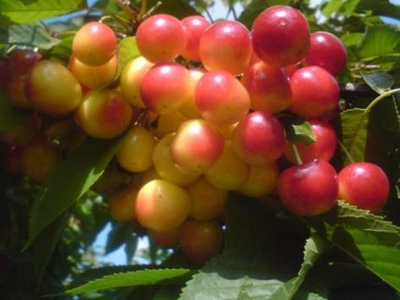
- Fruit shape: heart-shaped
- Foliage: good
- Authors: Belarus
- Appeared when crossing: Red dense x Ember
- Growth type: medium-sized
- Appointment: universal
- Yield: high
- Tree height, m: 3-4
- Crown: pyramidal, raised, medium density
- Fruit size: large
Early cherry Delight has long been known to gardeners. It fully lives up to its name, bringing amazing-tasting universal fruit.
Breeding history
The plant was bred in the Republic of Belarus, at the Institute of Irrigated Horticulture. The breeder Turovtsev became the author of the variety. The parental pair were Red dense and Ugolyok.
Description of the variety
The average height of Tenderness is about 3-4 meters. The crown of a medium-sized tree is pyramidal, slightly raised. There is no critical thickening, but the foliage is quite good.
Shoots are brown, straight. The leaves are light green, with well-visible veins. The edges of the leaf plates are weakly serrated.
Fruit characteristics
The tree bears fruit of large dimensions. Heart-shaped berries weigh at least 6.8 g. They are colored yellow, but there is also a slight orange blush on the surface.
The pulp is dense, with a small amount of cartilage. It is yellow in color, but the juice is completely transparent. The stone does not differ in its large size, it departs perfectly from the pulp.
Taste qualities
Berries of Tenderness are very sweet. Their taste score is 4.8. The fruits can be used both when preparing fresh dishes and for canning. Fresh drupes have the greatest useful value.
Ripening and fruiting
In May, the tree begins to bloom. If it grows on a seed stock, then the ovaries will be formed 4 years after planting season. Cherry ripens early. By the middle of the second decade of July, the fruits can already be harvested.

Yield
Gardeners note the high yield of the variety. It is usually possible to harvest an average of 28 tons of cherries per hectare.
Growing regions
Tenderness is advised to grow in the North Caucasus region.
Self-fertility and the need for pollinators
Several cherries can be planted near Tenderness to harvest. If you want to grow only cherries, then you can pay attention to such varieties as Ovstuzhenka, Iput, Yantarnaya, Severnaya. No pollinators Tenderness does not form ovary.
Growing and care
For Tenderness, you need a well-lit place. The variety is recommended to be planted on flat terrain or small hills; it does not take root in the lowlands. There should be no apple or pear trees growing nearby. The groundwater should be deep enough. Young seedlings do not tolerate northern winds, and mature trees, in the presence of a constant draft, can even throw off the ovaries, so protection must also be provided.
Tenderness prefers medium loamy or sandy loam substrates.The soil should be light, quickly conduct air and moisture. Heavy infertile soils, soils with high acidity, peatlands and swampy lands are not allowed. In autumn, the soil is fertilized with organic matter in the form of compost, as well as potassium salt and superphosphate. By the spring, these dressings will completely mix with the soil, and planting can be carried out.
Disembarkation scheme of Tenderness - 5x3 meters. When planting, make sure that the roots are moist and not tangled. The earth is rammed gradually, adding layer by layer. The root collar is left on the soil surface. The planted seedling is spilled with two buckets of water, then mulch is put in the form of peat.
Growing Tenderness, you need to follow the basic rules of care. Plants are watered every week, this applies to young trees in the first season. Then the irrigation is reduced, bringing it up to three times during the growing season. But the weather conditions must also be taken into account. The trunk circle is loosened and weeded a couple of times per season.
Top dressing is given according to the classical scheme. Before flowering, the substrate is fertilized with nitrogen, during the formation of fruits - with potassium and phosphorus. After harvesting, superphosphates are added to the ground. Organics are allowed to be used only once every couple of years. Be sure to carry out spraying on the leaf and preventive treatments for diseases and pests.
Trees are distinguished by an average level of winter hardiness, therefore, they usually require shelter for the cold period. The trunk circle is mulched, then sprinkled with spruce branches. From above, the trees are also covered by tying up the material. After the snow falls, a snowdrift is formed around Tenderness. In order for the tree to winter well, water-charging watering is carried out in October.
Disease and pest resistance
Cherries, which are properly cared for, do not get sick. The tree also does not attract pests. Ailments can occur with high humidity. This is improper over-watering or constant spring-summer rains. These conditions cause fungus, so if your area is known for rainfall, antifungal medications should be used ahead of time.
In April, Tenderness is also sprayed against pests. Aphids or weevils appear on it rarely, but nevertheless, aphids or weevils appear, so early treatment with insecticides is also needed.






Review overview
The variety of Tenderness is liked by most summer residents. It attracts with a sweet dessert taste, large yields that can be used in many ways. Many sell the surplus harvest, since cherries are well transported.
The only frustration among gardeners is that the variety does not have a sufficient level of winter hardiness to grow it in harsh conditions.































































